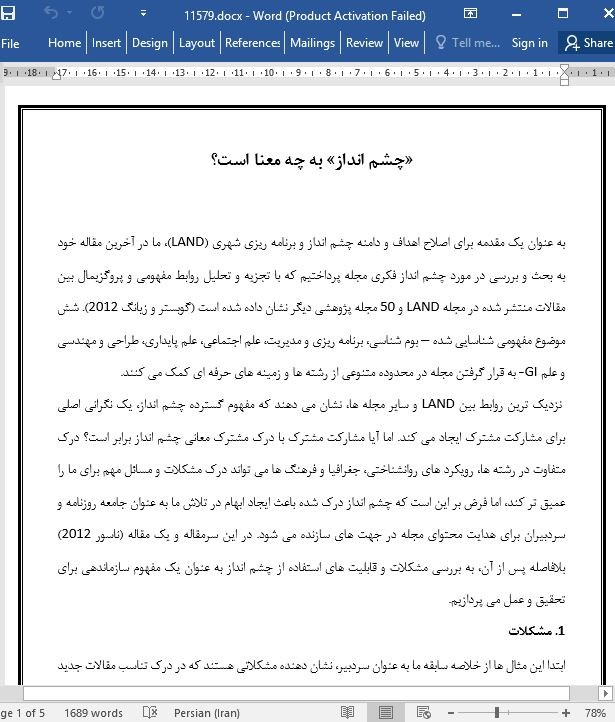
«چشم انداز» به چه معنا است؟
به عنوان یک مقدمه برای اصلاح اهداف و دامنه چشم انداز و برنامه ریزی شهری (LAND)، ما در آخرین مقاله خود به بحث و بررسی در مورد چشم انداز فکری مجله پرداختیم که با تجزیه و تحلیل روابط مفهومی و پروگزیمال بین مقالات منتشر شده در مجله LAND و 50 مجله پژوهشی دیگر نشان داده شده است (گوبستر و زیانگ 2012). شش موضوع مفهومی شناسایی شده – بوم شناسی، برنامه ریزی و مدیریت، علم اجتماعی، علم پایداری، طراحی و مهندسی و علم GI- به قرار گرفتن مجله در محدوده متنوعی از رشته ها و زمینه های حرفه ای کمک می کنند. نزدیک ترین روابط بین LAND و سایر مجله ها، نشان می دهند که مفهوم گسترده چشم انداز، یک نگرانی اصلی برای مشارکت مشترک ایجاد می کند. اما آیا مشارکت مشترک با درک مشترک معانی چشم انداز برابر است؟ درک متفاوت در رشته ها، رویکرد های روانشناختی، جغرافیا و فرهنگ ها می تواند درک مشکلات و مسائل مهم برای ما را عمیق تر کند، اما فرض بر این است که چشم انداز درک شده باعث ایجاد ابهام در تلاش ما به عنوان جامعه روزنامه و سردبیران برای هدایت محتوای مجله در جهت های سازنده می شود. در این سرمقاله و یک مقاله (ناسور 2012) بلافاصله پس از آن، به بررسی مشکلات و قابلیت های استفاده از چشم انداز به عنوان یک مفهوم سازماندهی برای تحقیق و عمل می پردازیم.
1. مشکلات
ابتدا این مثال ها از خلاصه سابقه ما به عنوان سردبیر، نشان دهنده مشکلاتی هستند که در درک تناسب مقالات جدید در حوزه و اهداف مجله با آن ها مواجه شده ایم:
As a prelude to revising the Aims and Scope of Landscape and Urban Planning (LAND), our last editorial discussed the journal’s “intellectual landscape” as revealed by an analysis of conceptual and proximal relationships between articles published in LAND and 50 other research journals (Gobster & Xiang, 2012). The six conceptual themes we identified—ecology, planning and management, social science, sustainability science, design and engineering, and GIScience—help situate the journal within a diverse range of disciplines and professional fields. The closest ties between LAND and other journals, however, suggest that the over-arching concept of landscape provides a core concern for shared involvement. But does shared involvement equate to a shared understanding of the meanings of landscape? Diverse understandings across disciplines, methodological approaches, geographies, and cultures can deepen our grasp of the problems and issues we care about, but simply assuming that landscape is well understood lends an ambiguity to our endeavor as a journal community and as editors in guiding journal content in productive directions. In this editorial and a companion essay (Nassauer, 2012) immediately following it, we examine the problems and potentials of using landscape as an organizing concept for scholarship and practice.
1. Problems
First, these examples from our brief tenure as editors illustrate some problems we have encountered in understanding the appropriateness of new submissions within the journal’s aims and scope:
1. مشکلات
2. قابلیت ها
1. Problems
2. Potentials
- اصل مقاله انگلیسی با فرمت ورد (word) با قابلیت ویرایش
- ترجمه فارسی مقاله با فرمت ورد (word) با قابلیت ویرایش، بدون آرم سایت ای ترجمه
- ترجمه فارسی مقاله با فرمت pdf، بدون آرم سایت ای ترجمه

